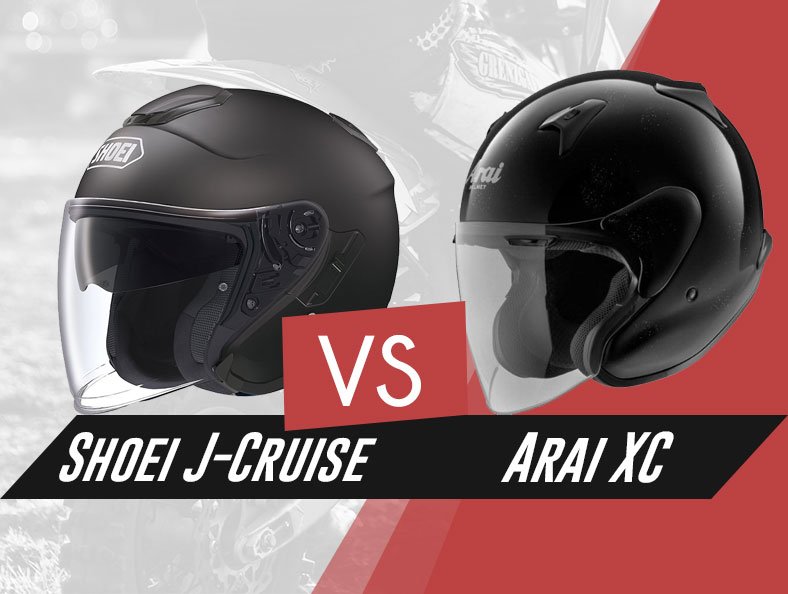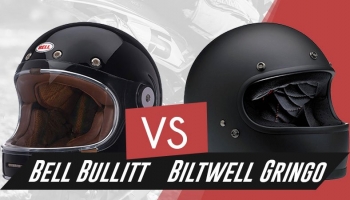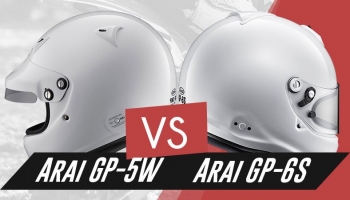Our Arai XC vs. Shoei J-Cruise Comparison for 2021

If you’ve been on the market for a new helmet, you’ve probably seen many Shoei and Arai models. The two brands are acknowledged as leaders and have much to offer in terms of quality, performance and of course, safety.
So far you’ve probably noticed the ongoing battle between their two helmets, the J-Cruise by Shoei an XC by Arai. The two models bring supreme technology and safety but how to choose between them?
We tested and compared the two in order to help you choose, so continue reading as we discuss their design, features, and safety.
Comparing Design, Features, and Construction
Shoei J-Cruise Design and Shape
J-Cruise is an open face helmet that comes in several sizes and colors. It has an intermediate oval shape, and it’s aerodynamic.
The shell is made of hand-laid interwoven layers of fiberglass, organic fibers and resin. It weighs about 3.75 pounds. The general shape makes it easy to carry around in hands if you’re not a fan of leaving it on the bike.
J-Cruise has a wider and taller field of vision, so the entire shape of the helmet gives you better peripheral vision as a whole. It protects you from UV rays, and you can always flip it when you need to.
The integrated air dam reduces turbulence inside the built-in shield making it more comfortable for long-distance rides. Overall, the design is quite modern especially if you opt for the black model.

Arai XC Design and Shape
Arai XC looks completely different. It’s also an open-face helmet but provides more coverage than most others on the market. The lower jaw-cheek area is extended which is the biggest design difference between the Arai XC and J-Cruise.
It has a medium round shape and comes in several sizes and shades. The face shield flips allowing you to use the helmet in two different ways. It’s a nice design feature that makes it easier to talk to people or even eat without taking off the helmet.
The shell has intake and exhaust vents as well as brow ventilation ducts. It’s the similar ventilation system you’ve probably seen on their RX-Q model. The helmet weighs about 4.6 pounds.

Comparing Safety Certifications
Shoei J-Cruise Safety
We’ve already mentioned that the J-Cruise is made of layers of fiberglass and resin. It’s durable and scratch-resistant which are the two qualities to look for in a safe helmet.
Another feature that adds to the overall safety is the distortion-free CJ-2 shield and a built-in internal sun shield. Its advanced ventilation helps prevent fogging while also maintaining a constant temperature in the shell. It prevents heat to build up as it’s always keeping the fresh air flowing.
The 3D Max-Dry interior system is comfortable and ensures your head is tightly in place. J-Cruise is DOT certified.
Arai XC Safety
Arai XC provides a comfortable and tight fit, so your head is secured into place. The cheek pads are removable so you can adjust them to achieve an even better fit.
The shield is scratch-resistant, so you’ll always see clearly through it. Plus, thanks to the brand’s original ventilation system, there’s no fogging messing with your vision as you ride.
Its shell is made of super fiber laminate with multiple-foam padding. The helmet is certified by the Department of Transportation as well as SNELL for its safety and reliability.
Learn more about ratings for safety.
Which Should I Buy?
Buying one of the two is often tricky since they both offer excellent safety and comfort. Both of these Japanese brands are reliable and have experience in the field.
However, they do have slight differences that can help you figure out which one is more suitable for your needs.
You Might Like the J-Cruise If...
You’re looking for outstanding airflow – J-Cruise has a large upper vent shutter for easier maneuverability when wearing riding gloves. It also has the first ever integrated air dam that does a lot for the entire construction. There’s no fogging, and the air within the helmet doesn’t warm up but remains fresh.
You want the best fit – the sizing is true to the chart, and the removable interior lining allows even more adjustability. The liner is 5mm thick while the cheek pad is about 31mm in total. It’s comfortable and fits just tight if you get it in the right size.
You want a versatile shield – this one provides a broad and tall field of vision with a shield that protects you from 99% of damaging UV rays. The 3D injection-molding provides a distortion-free view throughout. Its integrated air dam we mentioned earlier also reduces turbulence inside the shield.
See the Neotec review for another model from this brand, or the GT Air.
You Might Like the XC If...
You want simplicity – Arai XC is quite simple and easy to use. The medium round shape makes it equally as easy to carry around especially because it’s also lightweight. It has a very classic shape, and it comes in simple yet long-lasting colors.
You’re looking for a custom fit – helmets have to fit perfectly in order to fulfill their purpose. For this reason, Arai made sure to make this as customizable as possible. The helmet comes with multiple-foam interior material and removable cheek pads. You can work these around to find the best fit for the shape of your face, which is also convenient if you’re sharing the helmet with someone else.
You want more versatility – it’s an open-face helmet, but the brand improved the overall design for better looks and protection. XC has bigger coverage in the lower jaw-cheek area when compared with similar models on the market.
Conclusion
Hopefully, we managed to show the fundamental differences between these two industry-leading helmets. These Japanese brands are among the biggest names on the market, so you can’t go wrong with either quality wise.
It’s a matter of thinking about your preferences and needs. Think about what you want from a helmet and see which one of these two has that to offer. Consider their safety ratings and certifications as well as overall comfort and ease of use before you make the final decision.





